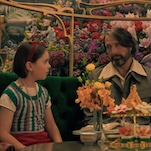The Legend Of Rita

Volker Schlöndorff's The Legend Of Rita opens with its best scene, an exhilarating and offhandedly funny staging of a bank robbery executed by a group of left-wing terrorists in '70s West Germany. Unlike other such robberies, they're motivated not by desperation or greed, but by the idealistic (and misguided) notion that they're striking a blow to the heart of capitalism. Apart from the sheer kineticism of the scene, Schlöndorff's perspective on the event is perfectly ambiguous. On the one hand, he sees this act of terrorism as petty and futile in light of the booming German economy, changing only the life of the lucky panhandler who receives a bag of Deutsche marks, the sole beneficiary of their redistribution of wealth. But on the other, he admires their youthful spirit and intense political commitment, which makes their crime seem oddly noble and even a little sexy. After such a slam-bang opening, perhaps Schlöndorff's liveliest moment in at least two decades of floundering, The Legend Of Rita never recaptures the same level of urgency, settling into a solid character study with occasional flashes of inspiration. Using the real-life activities of the left-wing Red Army Faction as a jumping-off point, Schlöndorff and co-screenwriter Wolfgang Kolhaase center the story on the fictitious title character, played with warmth and irrepressible vigor by Bibiana Beglou. After a few members of the group are arrested for their connection to the robbery, the others stage a jailbreak that goes awry, leaving an innocent person dead. The fallout from the incident requires them to flee West Germany for Paris, but when a cornered Beglou kills a French police officer, they have to move again, this time to East Germany, where they're aided by the secret service. Separated and given new identities, they're forced to operate within a socialist system as ordinary members of the working class. Schlöndorff could have easily taken the obvious route by poking fun at hard-line socialists who have problems adjusting to the reality of this way of life. But while he does get in a few good jabs, his portrait of Beglou is far more complex because she genuinely enjoys her modest life in East Germany, where there's "less poverty and less wealth." In its second half, The Legend Of Rita deals with her ironic alienation from the East German people, who generally don't share her contentment with the system and show little sympathy for anyone who would commit terrorist acts on its behalf. Though at times a little disorganized and underdeveloped—Beglou's intimate friendship with her East German roommate is a particular disappointment—the film looks back with nostalgia and affection at the last gasp of left-wing radicalism.








































